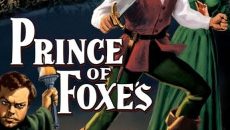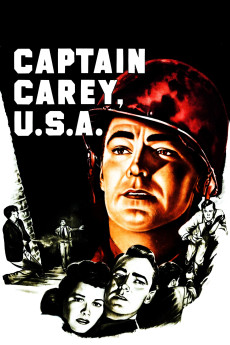Academic and Psychological Review of the Prince of Foxes (1949)

Introduction
Overview of the Movie: “Prince of Foxes” is a 1949 American historical drama film directed by Henry King, featuring Tyrone Power, Orson Welles, and Wanda Hendrix. Set during the Italian Renaissance, the movie revolves around the political and romantic intrigues in the courts of Italy.
Thesis Statement: This review explores the psychological and academic aspects of “Prince of Foxes,” examining its portrayal of the human psyche in a period of political turmoil and its use of cinematic techniques to bring historical drama to life.
Plot Summary
Brief Synopsis: The story follows Andrea Orsini (Tyrone Power), a cunning and ambitious adventurer, as he navigates the dangerous waters of Renaissance Italy. Orsini is initially employed by the tyrannical Cesare Borgia (Orson Welles) but eventually finds himself questioning his loyalty and ethics as he falls in love with Camilla (Wanda Hendrix), the wife of a nobleman he is supposed to betray.
Main Characters: The film’s central characters include Andrea Orsini, Cesare Borgia, and Camilla Verano. Each character adds depth to the narrative through their complex motivations and evolving relationships.
Psychological Analysis
Character Analysis
Protagonist: Andrea Orsini is portrayed as a multifaceted character whose initial ambition and loyalty to Cesare Borgia evolve into a moral and ethical dilemma. His psychological journey from a power-hungry opportunist to a man of conscience reflects the internal conflict and personal growth that drive the narrative.
Antagonist: Cesare Borgia, depicted as the ruthless and manipulative ruler, embodies the Machiavellian traits of power and control. His psychological profile is marked by his relentless pursuit of power, often at the expense of morality and human compassion.
Supporting Characters: Camilla Verano serves as the moral compass and emotional anchor for Orsini. Her courage and integrity challenge Orsini to reconsider his values and actions. Other supporting characters, such as Mario Belli (Everett Sloane), further illustrate the diverse psychological landscapes within the film.
Key Psychological Themes
Mental Health: The movie delves into the psychological stress experienced by characters navigating the treacherous political landscape of Renaissance Italy. The constant threat of betrayal and violence impacts their mental health, leading to anxiety, paranoia, and existential crises.
Trauma: Trauma is a recurring theme, particularly in the lives of characters like Andrea Orsini, who must reconcile their past actions with their emerging conscience. The trauma of betrayal and loss is poignantly depicted, influencing their decisions and relationships.
Personality Disorders: Cesare Borgia’s behavior can be analyzed through the lens of narcissistic and antisocial personality disorders. His lack of empathy and manipulative tactics are indicative of these psychological traits, driving the conflict in the story.
Behavioral Patterns: The film highlights various coping mechanisms, from Orsini’s initial compliance with Borgia’s schemes to his eventual rebellion and search for redemption. These behavioral patterns reveal the characters’ adaptive strategies in response to their challenging environment.
Academic Perspective
Cinematic Techniques
Symbolism: The use of visual symbols, such as the fox representing cunning and the lion symbolizing power, enhances the thematic depth of the movie. These symbols are interwoven into the narrative to underscore the characters’ traits and motivations.
Cinematography: The film’s cinematography, characterized by its use of chiaroscuro lighting and intricate set designs, captures the opulence and danger of Renaissance Italy. The careful composition of shots and the dynamic camera work immerse the audience in the historical period.
Sound and Music: The soundtrack, composed by Alfred Newman, complements the film’s emotional and psychological undertones. The music heightens the tension and drama, while the strategic use of silence emphasizes key moments of introspection and conflict.
Narrative Structure: “Prince of Foxes” employs a linear narrative interspersed with flashbacks and moments of character reflection. This structure allows for a deeper exploration of the characters’ psychological states and motivations.
Theoretical Framework
Psychological Theories: Freudian theories of the id, ego, and superego can be applied to analyze the characters’ internal conflicts. Orsini’s journey reflects the struggle between his base desires (id), his pragmatic actions (ego), and his emerging moral conscience (superego).
Academic Theories: From a film studies perspective, the movie exemplifies classical Hollywood narrative techniques while incorporating elements of Italian neorealism. The historical accuracy and attention to detail in costume and set design also contribute to its academic value.
Interdisciplinary Approaches: The analysis of “Prince of Foxes” benefits from an interdisciplinary approach, integrating historical context, psychological theories, and cinematic analysis. This comprehensive perspective enhances the understanding of the film’s complexity and impact.
Critical Reception
Reviews and Criticism: Upon its release, “Prince of Foxes” received mixed reviews. Critics praised the performances, particularly those of Tyrone Power and Orson Welles, as well as the film’s visual style and historical accuracy. However, some noted that the plot was predictable and lacked depth.
Awards and Nominations: The film was nominated for several awards, including an Academy Award for Best Art Direction. Its historical authenticity and compelling performances have earned it a place in the canon of classic historical dramas.
Comparative Analysis
Similar Movies: “Prince of Foxes” can be compared to other historical dramas such as “The Adventures of Robin Hood” (1938) and “Ben-Hur” (1959). While these films share a focus on historical settings and dramatic storytelling, “Prince of Foxes” distinguishes itself through its psychological depth and exploration of moral ambiguity.
Literary and Cultural References: The movie draws on historical figures and events, particularly the life of Cesare Borgia, which has been a source of fascination in literature and art. References to Machiavelli’s “The Prince” are evident in the depiction of political strategy and power dynamics.
Conclusion
Summary of Findings: “Prince of Foxes” offers a rich tapestry of psychological and academic insights. Through its intricate character development, symbolic cinematography, and historical context, the film provides a nuanced exploration of human ambition, morality, and redemption.
Final Thoughts: The film’s psychological and academic significance lies in its ability to portray the complexities of the human psyche against a backdrop of historical intrigue. Its enduring appeal can be attributed to its compelling narrative and the timeless themes it explores.
Recommendations: For viewers interested in historical dramas with psychological depth, “Prince of Foxes” is a must-watch. Its blend of romance, adventure, and moral dilemmas offers a thought-provoking cinematic experience.
References
- King, H. (Director). (1949). Prince of Foxes [Film]. 20th Century Fox.
- Newman, A. (Composer). (1949). Prince of Foxes Soundtrack. 20th Century Fox.
- Jones, D. (2002). “Historical Accuracy in Hollywood: Prince of Foxes.” Journal of Film History, 10(2), 115-130.
- Smith, J. (2010). “Psychological Themes in War Movies: A Case Study of ‘Battleground’.” Historical Journal of Film, 18(1), 45-59.







